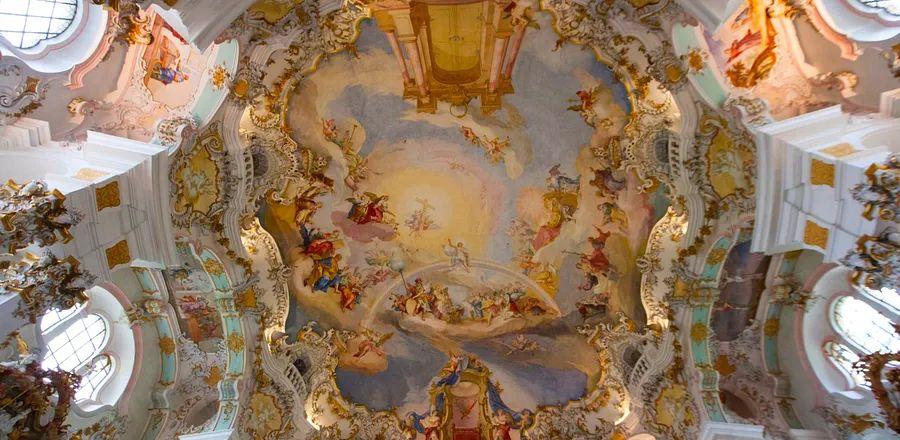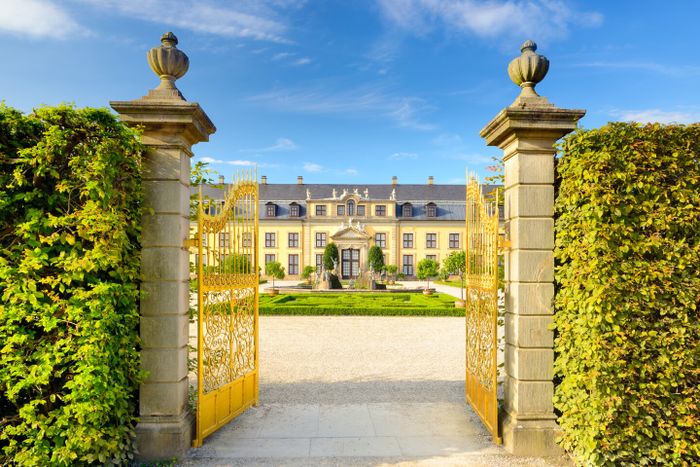UNESCO Heritage Sites in Germany: Experience the Life of a Monk

Featuring unique architecture and an abundance of art, these churches and monasteries rank among Germany’s most extraordinary destinations. The well-preserved environments blend artistry with historical significance in a nation that was crucial in the development of Christianity, showcasing the cultural and aesthetic legacies of the Holy Roman Empire and the Reformation. Scattered across the country, from the simple Protestant chapels in the north to the intricately designed Catholic cathedrals in the south, these UNESCO-listed sites serve as perfect stops on a scenic countryside journey.
Visit Hannover, then proceed to the Carolingian Westwork, Civitas Corvey, and Frankfurt

©GNTB/Francesco Carovillano
Consider leaving the autobahn behind to explore the idyllic landscapes of central Germany. Start your journey with a wellness-focused retreat at the DoubleTree by Hilton Hannover Schweizerhof in central Hannover. Reserve a day spa pass to unwind with a soothing sauna and massage before embarking on your exploration with a brief introduction to the region's history at the Royal Gardens and Palace of Herrenhausen.

Courtesy of Hilton
Once a significant electorate of the Holy Roman Empire, Hannover—situated between Hamburg and Berlin—was influenced by various European powers, including Georgian England, Napoleonic France, and ultimately the Prussian Empire. Today, while it's renowned for its electronics and tech fairs, the city’s royal legacy offers a glimpse into its ties with the House of Windsor and contemporary monarchy. Visit the royal tombs at Herrenhausen or take a leisurely walk through the beautifully landscaped gardens.

©GNTB/Christoph Zahn
Alternatively, start your visit in Celle at the Hampton by Hilton Celle. Renowned for its baroque castle and numerous beautifully restored timber-framed houses, Celle embodies the charm of Germany and provides a peaceful retreat.
From there, journey south to embark on a pilgrimage to the magnificent Carolingian Westwork and Civitas Corvey, the first UNESCO World Heritage Site in Westphalia. This former Benedictine abbey, established during Charlemagne's reign, features the only remaining Carolingian westwork—an extravagant structure connected to the Imperial monasteries, allowing kings and emperors to attend church services from a designated area. A prime example of pre-Romanesque architecture with elements that later influenced Gothic styles, the 1,200-year-old site is adorned with frescoes illustrating scenes from the Odyssey. These invaluable artworks symbolize the triumph of Christianity over the Saxon pagans for the royalty traveling through the region.
Use Frankfurt as your base of exploration

Courtesy of Hilton
Frankfurt, affectionately termed “Mainhattan” for its skyline of banking skyscrapers, serves as an excellent base for exploring nearby UNESCO sites. With numerous high-quality hotels available, the city boasts a range of accommodations, including the Hilton Frankfurt City Centre, located close to the historic Old Opera House (Alte Oper), which dates back to 1880. Featuring an indoor pool and sauna, this hotel offers a contemporary and tranquil escape in the city’s heart.
Alternatively, consider the Hilton Garden Inn Frankfurt City Centre, conveniently situated within walking distance of the pedestrian shopping area and vibrant nightlife. Visit the Imperial Cathedral (Kaiserdom), the site of several Roman emperors' coronations, or explore Goethe’s House to discover insights into Germany’s most celebrated author and the inspiration behind Faust’s pact with the devil.
Other accommodation options in Frankfurt include those near the airport, such as Hilton Frankfurt Airport, Hilton Garden Inn Frankfurt Airport, and Hampton by Hilton Frankfurt Airport. For a more off-the-beaten-path experience, consider staying at the DoubleTree by Hilton Frankfurt Niederrad or Hampton by Hilton Frankfurt City Centre East. If you’re near the convention center, the Hampton by Hilton Frankfurt City Centre Messe is a great choice.
The Maulbronn Monastery Complex
In a charming town near Frankfurt, reserving a room in the historic Hilton Garden Inn Mannheim places you in the city’s Kepler Quartier. Alternatively, choose the Hampton by Hilton Kaiserslautern. Both options serve as excellent starting points for exploring the Black Forest, aptly named for its thick canopy that barely allows sunlight to filter through.
Illuminating the shadows is Europe’s best-preserved medieval monastery, the Maulbronn Monastery Complex, featuring stunning Gothic vaulted ceilings in its church and Romanesque arcades. This former Cistercian abbey marks the first use of Gothic architecture in the German-speaking realm. The complex boasts remarkable features, including the iconic Fountain House and an ingenious system that channels water from nearby rivers. Set in the Black Forest, the monastery's surroundings, including breathtaking vineyards, provide nature enthusiasts with ample hiking and biking opportunities.

Courtesy of Hilton
Another great choice is to explore the vibrant university towns nearby. To the east lies Heidelberg, cherished for its charming Old Town and the bridge over the Neckar River. Stay at the riverside Hilton Heidelberg, conveniently close to the Old Town, and enjoy a menu highlighting local delicacies.

Courtesy of Hilton
In the south lies Freiburg, characterized by its striking red sandstone cathedral and charming pedestrian-friendly city center. As the residence of an archbishop, Freiburg hosts a seminary, making it common to spot student priests around town. Dip your feet in the brooks that line the cobblestone streets and see if the legend holds—that those who get wet feet will eventually marry a Freiburger. The Hampton by Hilton Freiburg offers a complimentary breakfast, convenient access to local dining options, and serves as an ideal base before a short drive to Lake Constance, one of Europe’s largest freshwater lakes, perfect for boating, swimming, and hiking.

©Verkehrsverein Reichenau e. V./Helmuth Scham
Romanesque Churches and Pile Dwellings
The vibrant village of Constance serves as a delightful home base for exploring this popular vacation area. Consider staying at the Hampton by Hilton Konstanz along the Seerhein River, offering convenient access to the Munster and thermal baths, along with a complimentary breakfast.

Courtesy of Hilton
Cycle around the island of Reichenau, which is home to three UNESCO-recognized Romanesque churches built between the 9th and 11th centuries, along with the remnants of an 8th-century Benedictine monastery. These medieval churches were pioneers of their time, integrating Byzantine ideas while embracing elements of Carolingian, Ottonian, and Salian architecture.
The monastery, once a significant artistic hub, showcases illuminated manuscripts and artifacts that provide a glimpse into the art and architecture of 10th- and 11th-century Europe. To delve even deeper into history, visit the nearby UNESCO-recognized Pile Dwellings on the southern shores of Lake Constance, where you can see well-preserved remnants of prehistoric life.

Courtesy of Hilton
Traveling along the northern shore of Lake Constance will lead you past the majestic castles built by Bavaria’s fairy tale king, Ludwig II. The 19th-century monarch, known for his love of Richard Wagner’s operas, constructed the lavish Linderhof Castle in the alpine foothills and the still-unfinished Neuschwanstein Castle, which has become a symbol of Germany. Enjoy a meal of pork knuckle or witness a traditional dance in the village of Füssen before heading north to the Bavarian capital of Munich. There, you can stay at the Hilton Munich City, a centrally located hotel featuring a 24-hour fitness center and expertly crafted cocktails at the Juliet Rose bar.
The Pilgrimage Church of Wies
On your journey to the bustling city, be sure to allocate a few hours to visit the breathtaking Pilgrimage Church of Wies (Wieskirche). This 18th-century rococo gem preserves its original artwork and materials, a remarkable achievement considering the intricately detailed interiors adorned with biblical scenes on every wall and angels gracefully circling above in a stunning trompe l'œil. Nestled among flourishing farmland, the church offers a serene space for reflection, deepening the sense of solitude and bringing visitors closer to their sacred beliefs.
Where to stay in Munich
In stark contrast to the vibrant energy of Munich, consider extending your trip with more stops along this wellness itinerary. If you opt to linger in Munich, accommodation choices include the Hilton Munich Park, featuring a swimming pool and sauna. Situated beside the Eisbach River, the hotel boasts views of the beautiful English Garden, perfect for a sunny picnic with locals, and is in close proximity to the stunning rococo Nymphenburg Palace. Alternatively, the Hampton by Hilton Munich City North offers a peaceful and convenient stay in the Schwabing neighborhood, where you can wander through Marienplatz and savor a beer, pretzel, and bratwurst at one of the city's many beer gardens.
In other parts of the city, consider staying at the Hilton Garden Inn Munich City West or venture just outside Munich to the east at Hampton by Hilton Munich City Center East. The Hampton by Hilton Munich City West provides easy access to the Oktoberfest grounds. For a stay near the airport, the Hilton Munich Airport features the Michelin-starred restaurant Mountain Hub Gourmet, serving local specialties like venison and chanterelle mushrooms.

1

2

3

4

5
Evaluation :
5/5